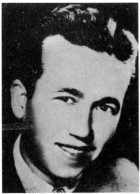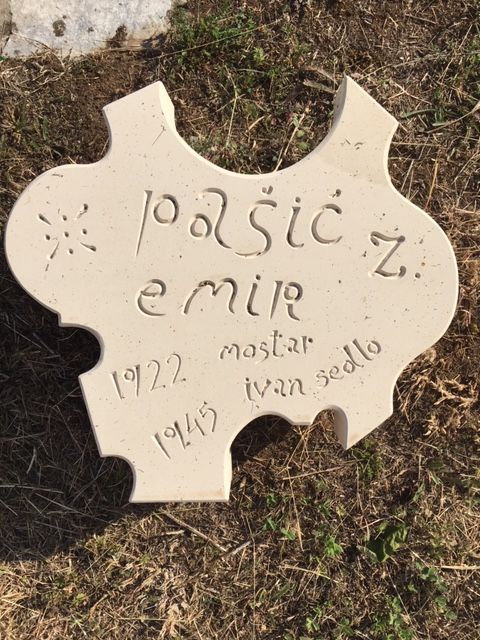
brochure "Partizanski spomenik u Mostaru" (1980)
book “Spomenica Mostara 1941-1945.”
another document or proof of the memorial stone (e.g., a photograph).
Emir Z. PAŠIĆ
EMIR PAŠIĆ, son of ZAJKO, born on February 13, 1922, in Mostar, a student of the Commercial Academy. A member of the League of Communist Youth (SKOJ), a fighter in the 2nd Battalion of the 13th Herzegovinian Brigade, a political delegate of the 1st Platoon of the 2nd Battalion, and a passionate photo-reporter. Seriously wounded in successive assaults on Mount Rogalj (Ivan Planina) on March 6, 1945. In an attempt to save him and the wounded machine gunner Toma Krajišnik, three nurses, one next to the other, were killed: Zdenka Karačić, a nurse of the Second Battalion, Ljubica Remetić from the village of Biograd near Nevesinje, a sanitary officer of the Fourth Battalion, and Emina Merdan from Počitelj, a nurse of the Second Battalion. They were killed “at the Dragalj position, above the mountain pass at Ivan Saddle, in front of enemy bunkers, fifty-something meters away from the positions held by the 13th Brigade battalions.” The symbolism of these deaths resonated for a long time within the battalion, as well as after the war, through numerous stories: “the feat of Zdenka, Emina, and Ljubica remained a symbol of blood-sealed brotherhood and unity of our three peoples.”
Mensur Seferović published an article about that event many years after the war. Lutvo Džubur wrote about it in an article titled “The Three of Them”, published in the newspaper of the 13th Brigade, “Hercegovački borac” (Herzegovinian Fighter):
“The first one to go was Ljubica. She reached the wounded comrade and pulled him back. Just at that moment when she thought the task was accomplished, that the comrade was saved, Ljubica collapsed in the snow, hit by a shot in the stomach. Zdenka and Emina, who were attentively watching Ljubica’s attempt from their cover, knew what their duty was now. No orders were needed. Conscience is stronger than anything. They rushed towards Ljubica and the wounded comrade, not thinking about the danger and ignoring the enemy bullets that were tearing through the snow around them. But… the villainous eye had aimed well. Zdenka fell, hit in the head, and right beside her, Emina, hit in the chest. The three young women from Herzegovina lay motionless side by side. Strong jets of blood soaked the snow and colored it with a beautiful blush in the sunlight. And the lives of three young people gradually faded away on the first hill in Bosnia.”
According to the archives of Radmilo Braca Andrić, the remains of Emir Pašić were transferred and buried in the Partisan Memorial Cemetery in Mostar.
Ćemalović, Enver (1986): Mostarski bataljon, Mostar; Seferović, Mensur (1964): Partizanski kolopleti, „Narodna armija“, Beograd; Džemil Šarac, članak „Sa Mostarcima“, Hercegovina br 9, str 221; Seferović, Mensur (1970): Pred očima grada, »Informativni centar Mostar«, nagrada »14. februar« Skupštine opštine Mostar, 1970.; Seferović, Mensur: Mostarski kolopleti, edicija “Mostar u borbi za slobodu”, knjiga 8, Mostar; grupa autora (1986): Hercegovina u NOB 4. dio, Beograd; Konjhodžić, Mahmud (1981): “Mostarke”: fragmenti o revolucionarnoj djelatnosti i patriotskoj opredjeljenosti žena Mostara, o njihovoj borbi za slobodu i socijalizam, Opštinski odbor SUBNOR-a Mostar; Seferović, Mensur (1957): „Tajna partijske ćelije“, Sarajevo; Borbe I Antifašistički Otpor U Mostaru (yu-nostalgija.com) ; http://rsdvelezmostar.blogspot.com/p/fk-velez.html ; група аутора (1986): Херцеговина у НОБ, Београд ; Seferović, Mensur (1984): Rascvjeti bratstva, “Narodna armija”, Beograd; Seferović, Mensur (1988): Trinaesta Hercegovačka NOU Brigada, Beograd; grupa autora: Spomenica Mostara 1941-1945
Photo of the memorial plaque: S. Demirović
Do you have more information about this fighter? Share your stories and photographs. Let's keep the memory alive!

